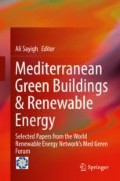Abstract
A well-calibrated model is crucial to accurately represent a building’s energy profile. This chapter deals with a building where an underfloor heating system supplied by a geothermal water-to-water heat pump and natural ventilation are the main systems used to maintain comfort conditions. Existing methodologies to establish calibration accuracy are mainly based on whole-building energy consumption comparisons. This research considers whole-building energy consumption with a breakdown of end-use energy consumption. The objective of this work is to develop a two-level calibration methodology which starts with calibration and then continues with the necessary actions for improving building energy efficiency. Finally, the model was simulated to estimate the potential of energy-efficiency improvements. The results of the analysis show that electricity consumption savings and heat released from the heat pump can vary between 20 and 27 % on a monthly basis.
References
Perez-Lombard L, Ortiz J, Pout C (2008) A review on buildings energy consumption information. Energy Build 40:394–398
Directive 2010/31/EU of the European Parliament and of the Council. On the energy performance of buildings. Articles 14–16, 19 May 2010
Raftery P, Keane M, Costa A (2011) Calibrating whole building energy models: detailed case study using hourly measured data. Energy Build 43:3666–3679
Bertagnolio S (2012) Evidence based model calibration for efficient building energy services. Ph.D. Thesis, University of Liège
Menezes AC, Cripps A, Bouchlaghem D, Buswell R (2012) Predicted vs. actual energy performance of non-domestic buildings: using post-occupancy evaluation data to reduce the performance gap. Appl Energy 97:355–364
Liu G, Liu M (2012) A rapid calibration procedure and case study for simplified simulation models of commonly used HVAC systems. Build Environ 46:409–420
CarbonBuzz-website. http://www.carbonbuzz.org
Hamilton I, Steadman P, Bruhns H (2011) CarbonBuzz—energy data audit, UCL Energy Institute, July 2011
EnergyPlus Version 8.2 (2014) U.S. Department of Energy, Energy Efficiency and Renewable Energy, Office of Building Technologies. http://www.energyplus.gov
ASHRAE guideline 14 (2002) Measurement of energy and demand savings. American Society of Heating, Refrigerating, and Air-Conditioning Engineers, Atlanta, GA
Mustafaraj G, Marini D, Costa A, Keane M (2014) Model calibration for building energy efficiency simulation. Appl Energy 130:72–85
Azar E, Menassa C (2012) A comprehensive analysis of the impact of occupancy parameters in energy simulation of office buildings. Energy Build 55:841–853
Morris M (1991) Factorial sampling plans for preliminary computational experiments. Technometrics 33:161–174
De Wit S, Augenbroe G (2002) Analysis of uncertainty in building design evaluations and its implications. Energy Build 34:951–958
Heiselberg P, Brohus PH (2007) Application of sensitivity analysis in design of sustainable buildings. Proceedings of the international conference on sustainable development in building and environment, Chongqing, China
DesignBuilder. www.designbuildersoftware.com
CIBSE Guide (2006) A environmental design. The Chartered Institution of Building Services Engineers, London
ASHRAE Fundamentals Handbook (2005) Atlanta: American Society of Heating, Refrigerating and Air-Conditioning Engineers, Inc
ASHRAE Standard 62.2 (2013) Ventilation and acceptable indoor air quality in low-rise residential buildings
Author information
Authors and Affiliations
Corresponding author
Editor information
Editors and Affiliations
Rights and permissions
Copyright information
© 2017 Springer International Publishing Switzerland
About this paper
Cite this paper
Mustafaraj, G. (2017). High Quality of Calibration Accuracy for Smart Building Energy-Efficiency Opportunities. In: Sayigh, A. (eds) Mediterranean Green Buildings & Renewable Energy. Springer, Cham. https://doi.org/10.1007/978-3-319-30746-6_34
Download citation
DOI: https://doi.org/10.1007/978-3-319-30746-6_34
Published:
Publisher Name: Springer, Cham
Print ISBN: 978-3-319-30745-9
Online ISBN: 978-3-319-30746-6
eBook Packages: EnergyEnergy (R0)

